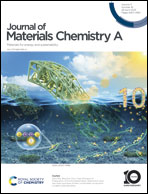Improving the performance for direct electrolysis of CO2 in solid oxide electrolysis cells with a Sr1.9Fe1.5Mo0.5O6−δ electrode via infiltration of Pr6O11 nanoparticles†
Abstract
Direct CO2 electrolysis using solid oxide electrolysis cells (CO2-SOECs) holds promise to efficiently convert carbon dioxide to carbon monoxide and oxygen. Cathodes with desirable catalytic activity and chemical stability play a critical role in the development of direct CO2-SOECs. Although Sr2Fe1.5Mo0.5O6−δ (SFM) has exhibited promise for direct CO2-SOECs due to its redox stability, it suffers from insufficient activity for the CO2 reduction reaction (CO2RR). Here we report interface engineering of nanosized Pr6O11 on the SFM cathode obtained through infiltration to promote the CO2RR performance for direct CO2-SOECs. The effect of Pr6O11 loading on the performance of the CO2RR is systematically investigated. At 800 °C, the current density of the Pr6O11 infiltrated SFM cathode with an optimum Pr6O11 loading of 14.8 wt% reaches 1.61 A cm−2 at 1.5 V, more than double that of the SFM cathode (0.76 A cm−2) under the same operating conditions. X-ray photoelectron spectroscopy (XPS) characterization and in situ diffuse reflectance infrared Fourier transform spectroscopy (DRIFTS) analysis indicate that the adsorption ability of CO2 on the SFM cathode has been significantly improved by the formation of Pr6O11. Temperature-programmed desorption (TPD) of CO2 measurements further manifest that a 14.8 wt% Pr6O11-SFM cathode has better CO desorption capacity. In addition, polarization resistance of the SFM cathode has significantly decreased with the addition of Pr6O11. Three-electrode measurement was used to analyze the improved electrode kinetics. These results demonstrate that the formation of Pr6O11 in the SFM cathode through infiltration is a promising approach for increasing CO2RR activity for CO2-SOECs.



 Please wait while we load your content...
Please wait while we load your content...